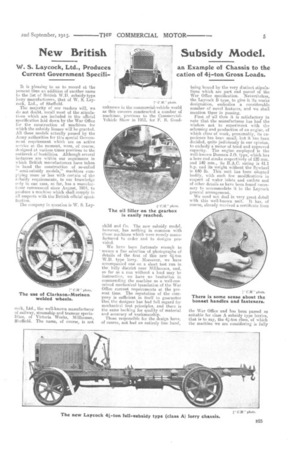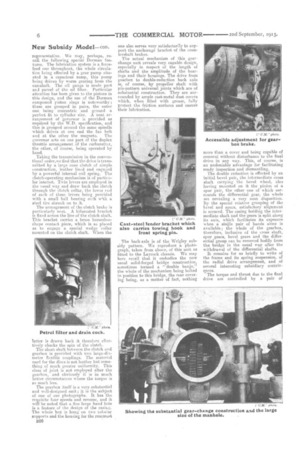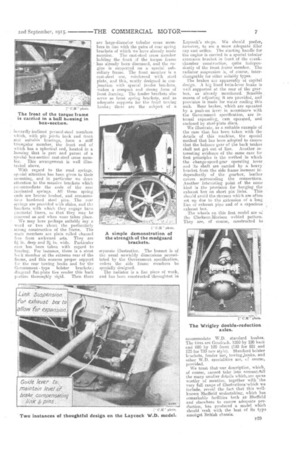New British Subsidy Model.
Page 5

Page 6

Page 7

If you've noticed an error in this article please click here to report it so we can fix it.
It is pleasing to us to record at the present time an addition of another name to the list. of British W.D. subsidy-type lorry manufacturers, that of W. S. Laycock, Ltd., of Sheffield. The majority of our readers will, we do not doubt, recall most of the stipulation e which are included in the official specification laid down by the War Office for the construction of machines -for which the subsidy licence will be granted. All those models actually passed by the Army authorities for this special Government requirement which are on active service at the Moment, were, of course, designed at various times previous to the outbreak of hostilities. Although several instances are within our cognizance in which British manufacturers have taken in hand the construction of so-called " semi-subsidy models," machines complying more Or less with certain of the subsidy requirements, to our knowledge only in one case, so far, has a manufacturer commenced since August, 1914, to produce a machine which shall Comply in all respects with the British official specification.
The company in question is W. S. Lay
ccck, Ltd., the well-known manufacturer of railway, steamship and tramcar specialities, of Victoria Works, Millhouses, Sheffield. The name, of course, is not
unknown in the commercial-vehicle world as this concern constructed a number of machines, previous to the CommercialVehicle Show in 1913, for F. B. Good child and Co. The new subsidy model, however, has nothing in common with those machines which were merely manufactured to order and to designs provided.
We have been fortunate enough to secure a fine selection of photographs of details of the first of this new 4i-ton W.D. type lorry. Moreover, we have accompanied one on a short test run in the hilly district near 'Millhouscs, and, so far as a run without a load may be instructive, we have no hesitation in commending the machine as a well-conceivedmechanical translation of the War Office current requirements at the present time. The reputation of the company is sufficient in itself to guarantee that the designer has had full regard for mechanical first principles, and there is the same backing for quality of material and accuracy of workmanship. Those responsible for the design have, of course, not had an entirely free hand,
being bound by the very distinct stipulations which are part and parcel of the -War Office specification. . -IceVertheless, the Laycock B type, to _give it its works designation, embodies . a considerable number of novel "features, and we shall mention these in passing.
First of 'all then it is satisfactory to note that the Manufacturer has had the wisdom not to experiment with the scheming and production of an engine, of which class of work, presumably, its experience has been small, but it has been decided, quite judiciously in our opinion, to embody a-motor of tried and approved capacity. The engine employed is the well-known Dorman J.O. type, which has a bore and stroke respectively of 120 mm. and 140 mm., its H.A.e. rating is 41.1 h.p. and its weight without the flywheel is 640 lb. This unit has been adopted bodily, with such few modifications in respect of water inlets and outlets and of other details as have been found necessary to accommodate it to the Laycock general arrangement.
We need not deal in very great detail with this well-known unit. It has, of course, already received a certificate from the War Office and has been passed as suitable for class A subsidy type lorries, that is to say, the 4k-ton class, of which the machine we are considering is fully representative. We may, perhaps, rocall the following special Dorman features. The lubrication system is a forcefeed one throughout, the whole circulation being effected by a gear pump situated in a capacious sump, this pump being driven by worm gearing from the camshaft. The oil gauge is made part and parcel of the oil filter. Particular attention has been given to the pistons in this design, and the use of the Dorman compound piston rings is noteworthy ; these are grouped • in pairs, the outer one being concentric and ground a perfect fit to cylinder size. A neat arrangement of governor is provided as required by the W.D. specification, and this is grouped around the same spindle which drives at one end the fan belt and at the other the magneto. The governor acts on one part of the duplex throttle arrangement of the carburetter, the other, of course, being operated by hand.
Taking the transmission in the conventional order,we find that the drive is transmitted by a large cone clutch of simple construction, leather lined and engaged by a powerful internal coil spring. The dutch-operating mechanism is of particular interest. Twin levers are employed in the usual way and draw back the clutch through the clutch collar, the lower rnd of each of these levers being provided with a small ball bearing each with a steel tire shrunk on to it.
The arrangement of the clutch brake is particularly neat. A bifurcated bracket is fixed across the line of the clutch shaft. This bracket carries a brass horseshoeshape contact piece, which is so placed as to engage a special wedge collar mounted on the clutch shaft. When the latter is drawn back it therefore effectively checks the spin of the clutch.
The short shaft between the clutch and gearbox is provided with two large-diameter flexible couplings. Ile material used for the discs is not leather but:something of much greater uniformity. This class of joint is not employed after the gearbox, and obviously it is in much better circumstances where the torque is BO much less.
The gearbox itself is a very substantial and well-designed unit ; it is the subject of one of our photographs. It has the requisite four speeds and reverse, and it will' be noted that a fine large hand hale is a feature of the design of the casing. The whole box is hung on two tubular supiairts and the housing for the rearmost one also serves very satisfactorily to support the anchorage bracket of the countershaft brakes.
The actual mechanism of this gearchange unit reveals very capable design, especially in respect of the length of shafts and the amplitude of the bearings and their housings. The drive from gearbox to double-reduction back axle is; of course, by propeller shaft with pin-pattern universal joints which are of substantial construction. They are surrounded by ample cast-metal dust covers which, when filled with grease, fully protect the friction surfaces and ensure their lubrication.
The back-axle is of the Wrigley subsidy pattern. We reproduce a photograph, taken from above, of this unit as fitted to the Laycock chassis. We may here recall that it embodies the now usual solid-forged bridge construction, sometimes termed a "double banjo," the whole of the mechanism being bolted in position to this bridge, the rear covering being, as a matter of fact, nothing
more than a cover and being capable of removal without disturbance to the final drive in any way. This' of course, is an undeniable advantage for facilitating ready inspection and dismantling. The double reduction is effected by an initial bevel pair, the intermediate cross shaft carrying the bevel wheel, also having mounted on it the pinion of a spur pair, the other one of which surrounds the differential gear, the whole set revealing a very neat disposition. 13v the special relative grouping of the bevel and spurs, satisfactory alignment is secured. The casing holding the intermediate shaft and the gears is split along its axis, which facilitates its exposure when a shigle pair of hands alone is available; the whole of the gearbox, therefore, inclusive of the cross shaft, spur gears, bevel gears and the differential group can be removed bodily from
i the bridge n the usual way after the withdrawal of the differential shafts.
It remains for us briefly to write of the frame and its spring suspension, ol the radial drive arrangement, and of several interesting subsidiary contrivances.
-The torque and thrust due to the final drive are controlled by a pair of inwardly-inclined pressed-steel members which, with pin joints back and front and suitable bracings, form a stiff triangular member, the front end of which has a spherical end, located in a housing that is part and parcel of a special box-section cast-steel cross member. This arrangement is well illustrated above.
With regard to the road springs, spacial attention has been given to their mounting, and in particular we draw attention to the massive brackets which ceornmodiate the .ends of the rear laminated springs. All these spring ends are bronze bushed, and accommodate hardened steel pins. The rear springs are provided with slides, and the brackets with which they engage have gunmetal liners, so that they may be renewed as and when wear takes place. . We may here perhaps suitably say a word or two about the particularly strong construction of the frame. The main members are plain rolled channel free from awkward sets. They are
in deep and 2i in. wide. Particular care has been taken with regard to bracing. For instance, there is a stout b Irk member at the extreme rear of the frame, and this ensures proper support for the rear towing hooks and for the
Government type bolster brackets; diagonal flat-plate ties render this back portion thoroughly rigid. Then there are large-diameter tubular cross members in line with the pairs of rear spring brackets of which we have already made mention. The cast-steel cross member holding the front of the torque frame has already been discussed, and the engine is supported on a special subsidiary frame. The front member is a cast-steel one, reinforced with steel plate, and this, neatly designed in conjunction with special fender brackets, makes a compact and strong form of front framing. The fender brackets also serve as front spring brackets, and as adequate snpports for the front towing hooks; these are the subject of a
separate illustration. The bonnet is of the usual unwieldy dimensions necessitated by the Government specilication, -unless the side frame members be specially designed.
The radiator is a fine piece of work, and has been constructed throughout in
Laycock's shops. We should prefer, however, to see a more adequate filler cap and orifice. The starting handle for the engine is carried in a special tubular extension bracket in front of the crankchamber construction, quite independently of the front frame member. The radiator suspension is, of course, interchangeable for other subsidy types.
The brakes are apparently of capital design. A big lined twin-lever brake is well supported at the rear of the gearbox, as already mentioned: 'Sensible means of adjusting it are provided, and provision is made for water cooling this unit. Rear brakes, which arc operated by a push-on lever in a,ccordanee with the Government specification, are internal expanding, cam operated, and enclosed by steel-plate discs.
We illustrate, as a suitable example of the care that has been taken with the details of this machine, the special method that has been adopted to ensure that the balance gear of the back brakes
shall not get out of line. Another interesting evidence of the same care for first principles is the method in which the change-speed-gear operating lever and its shaft are carried by a heavy bracket from the Bide frame memner in-dependently of the gearbox leather covers surrounding the connections. Another interesting point of the same kind is the provision for hanging the
exhaust box on short pin links. This shouW avoid the stresses which are often set up due to the pxtension of a long line of exhaust pipe and of a capacious' exhaust box.
The wheels on this first model are the Clarkson-Morison welded pattern. They are, of course, constructed to accommodate W.D. standard bushes. The tires are Goodrich. 1050 by 120 hack and 880 by 120 front (120 for 881 and 120 for 730 new style). Standard bolster brackets, fender bar, towing,hooks..and other W.D. specialities are, of course, provided. We trust that-our description, which, of course, cannot take into sccountil'all the many smaller details whiclnare quite worthy of mention, together with 'the very full range of illustrations 'which we include, reveal the fact that this wellknown Sheffield undertaking, which has remarkable facilities both at' Sheffield and elsewhere to ensure adequate production, has produced a model which should rank with the best of its type amongst British chassis.




















